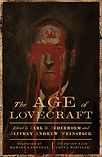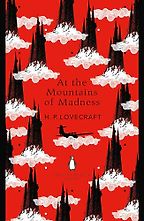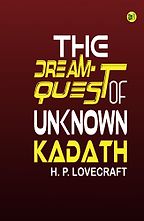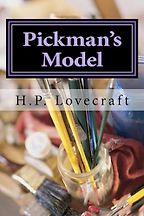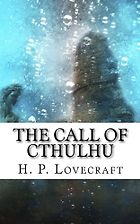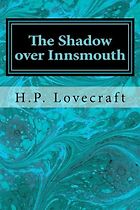Who is H. P. Lovecraft?
H.P. Lovecraft was an American author of horror tales who primarily published in the 1920s and the 1930s, in what are called pulp fiction magazines, printed on cheap paper. He was not very well known during his lifetime, beyond a small group of advocates, but his reputation has grown steadily across the 20th and into the 21st century.
You co-edited a book on his work, The Age of Lovecraft, which looks, among other things, at the growth of his popularity – you phrase the question as ‘Why Lovecraft? Why now?’. How do we account for his huge popularity today?
It’s been a gradual process of his reputation growing after his death. He had a small group of advocates who founded a press called Arkham House for the sole purpose of keeping his work in publication. Gradually, he attracted fans who then went on to become makers of popular culture – people like Stephen King and John Carpenter rallied around his work, and then begat people like Guillermo Del Toro today, who is also a fan of Lovecraft. So we’ve seen a gradual expansion of Lovecraft’s reputation.
As to what explains the popularity… I think there are a number of different factors that are involved here. Some of it is just a general mainstreaming of horror and science fiction and fantasy, which are much more popular in general than they ever were in the past. Then you have people like Stephen King, Neil Gaiman (although he’s fallen from grace in a number of respects), who was also an advocate of Lovecraft, and China Miéville, who’s a contemporary author of weird fiction and is cut from the same cloth as Lovecraft. And it may well be that his philosophical perspective, something that’s sometimes referred to as ‘cosmic dread’ or ‘cosmic indifferentism’, is something that we find appealing today. It’s the idea that in the larger scheme of things, in light of the vast expanse of deep time and interstellar space, we as human beings really don’t amount to very much. That was a philosophy that’s embedded within his fiction in the 1920s and the 1930s, and I think we may have caught up to that at this point, thinking about ourselves in relation to larger cosmic forces.
Your first choice is a foundational Lovecraft text: could you tell us about The Call of Cthulhu?
The Call of Cthulhu was published in 1928, and it is Lovecraft’s most famous story. It’s a story that’s told in several parts, in which an investigation pieces together, from various clues, the existence of monstrous forces that have impinged upon our world. It introduces the monstrous figure, Cthulhu, who is a tentacle-faced extraterrestrial entity so powerful that human beings can’t resist, so much as just try to keep our heads down and not attract its attention.
Lovecraft is famous now for something called the Cthulhu Mythos, which is a group of stories that share this world he invented. It takes its name, obviously, from Cthulhu, who is one of a pantheon of these extraterrestrial, interdimensional entities that – should they bother to notice us – could squash us out of existence.
In your introduction to The Age of Lovecraft, you noted that this world was one of the first shared fictional universes, as other people were invited to play around in it…
Yes, I think that’s another reason that Lovecraft’s popularity blossomed. I tend to think of it as an open-source universe. Lovecraft had a series of interconnected stories, and introduced entities and gods such as Cthulhu. Other authors were then, with his blessing, invited to participate in developing that universe further. August Derleth, for example, contributed his own gods to Lovecraft’s mythos.
One of the other things that I think made Lovecraft endure is that, although he wasn’t terribly well known during his lifetime, he was a voluminous letter writer, and really offered a lot of encouragement to young authors who were interested in writing fantasy and science fiction and horror – including for example Robert E. Howard, the creator of the Conan the Barbarian novels, and Robert Bloch, the author of Psycho. He really was generous in that respect.
Let’s keep going with the Cthulhu Mythos… Your second choice is At the Mountains of Madness. Could you introduce us?
At The Mountains Of Madness is one of Lovecraft’s longer contributions to speculative fiction, and it develops the Cthulhu Mythos much more fully. It’s about an Antarctic expedition that penetrates further into the continent than any expedition preceding it, and discovers evidence of a long-abandoned city. As they begin to explore the city, they piece together a story about extraterrestrial entities that preceded human life on the planet by millennia. They had conflicts among themselves, and had servants called shoggoths, who were amorphous blobs of protoplasm that could be shaped in different ways… So, we get a whole history of another civilization, a very powerful one, traces of which are still present in our universe. It’s really an exercise in world-building.
Sounds like ‘cosmic indifferentism’…
Very much so. And the irony with Lovecraft is that, on the one hand, he has this notion of indifferentism, or cosmic dread that human beings don’t matter very much. At the same time, the difficulty with him is that he’s notorious for his racism. So, on the one hand, human life doesn’t matter; but in his day-to-day existence, some humans did matter much more than others. And that’s the kind of “sticky wicket” that we have with Lovecraft that we have to keep coming back to: the racism is braided into his fiction in such a way that you can’t really extricate it. A lot of the motor force of his fiction is anxiety about things like miscegenation or hybrids, which we’ll talk about a little bit more, actually, with the next story.
Let’s talk about that next choice then, and explore this question a bit more. Could you start by telling us about The Shadow Over Innsmouth?
The Shadow Over Innsmouth is a story from 1931 involving a trip that goes awry, we could say. We have a character who is traveling through New England, who boards a bus and ends up in the town of Innsmouth. It’s a quintessential Lovecraft setting: an old, decaying seaport town with inscrutable characters. A dark history begins to emerge, and the revelation is that there are creatures under the sea called the deep ones, that have interbred with the human beings that lived in Innsmouth. At a certain age, people who grow up in Innsmouth then go into the water, and they go down into the deep to join the deep ones who dwell below the waves. Then there’s a twist at the end…
Why did this particular story make your list?
This one is exemplary of the atmosphere that Lovecraft seeks to develop throughout his fiction, notably these decaying New England seaports in which everything seems ominous and inscrutable.
And you mentioned that this story is an important one for understanding the relationship between his racist views and his fiction?
Yes. Lovecraft harkened back to the idea of being the 18th-century gentleman. Although racism was obviously common in the 1920s, 30s and 40s, Lovecraft was racist even by the standards of the time period.
What seems to repulse him most in his fiction is the idea of hybrid entities or miscegenated creatures, and that’s the source of much of the horror in his fiction – the idea that humans have interbred with either species from other planets or with animals. So you get creatures that are hybrids. China Miéville, who is an author of weird fiction in his own right, says that this racism is not ‘epiphenomenal’ in Lovecraft, it’s not something on the surface that can simply be sort of ignored. It’s actually what moves his fiction along. The source of the horror in Lovecraft comes from his racism and his anxieties about the ‘encroachments’ of people of colour. He has a story called The Horror at Red Hook, which is not on my list, but reflects a period of time when he lived in a section of Brooklyn in New York called Red Hook – and the story is just all about how the ethnically diverse population is, to him, so frightening and ominous. He speaks about people of colour, of various ethnicities, as though they are subhuman.
I’m guessing that story is not still as widely read…
The interesting thing about The Horror at Red Hook is that it was somewhat recently rewritten by a contemporary author of horror fiction named Victor LaValle, who has published it as The Ballad of Black Tom. It’s a retelling of The Horror at Red Hook that shifts the location of horror away from the ethnically diverse population of Red Hook and instead focuses on racism itself, as being what truly is the horror at the heart of the story.
There have been a lot of adaptations and reinterpretations of Lovecraft, in all sorts of media…
Yes. What I think is most interesting about the way that Lovecraft is being utilized today is the attempts to honour his legacy and his contributions to the genre, while at the same time operating in a mode of critique, highlighting the fact that there are these objectionable aspects to his fiction. Victor LaValle’s re-scripting of The Horror of Red Hook is a good example of that. Or the HBO series, Lovecraft Country, does something very similar. It takes a book of the same name by Matt Ruff, and in the HBO series version, you have Lovecraftian monstrosities – shoggoths and other kinds of monsters – but the focus is on a black family in 1950s America who are encountering racism as part of their day to day experience, which is as scary as (if not scarier than) the Lovecraftian monsters. So it’s the revisions of him that are very fascinating. You can have an homage or acknowledge his significance, but at the same time – rather than cancelling him and just not mentioning him – rewriting him in ways that take that racism that was central to his fiction, and highlight that as being what the true horror actually is.
Let’s look at your fourth choice, which takes us to the Dreamlands. Could you tell us about The Dream-Quest of Unknown Kadath?
This one is a lesser-known Lovecraft. Most people who know Lovecraft probably encounter his horror stories and the Cthulhu Mythos. But he also functioned in a fantasy framework, and he has a lot of fiction that was influenced by the Anglo-Irish author Lord Dunsany, who developed these fantasy excursions into other worlds – less horrific, and more fantasy fiction. The Dream-Quest of Unknown Kadath functions very much in that register.
You have a character named Randolph Carter who, through a process of dreaming, enters what Lovecraft calls the Dreamlands. He sojourns through this world, encountering different kinds of monsters and obstacles, things to overcome before ultimately returning to the waking world. It has a sense of whimsy to it that I think is really enjoyable, and differentiates it from his Cthulhu mythos stories, which primarily operate in a horror register.
Is that true of everything in the Dream Cycle? I know there’s a longer list of works in this world…
Yes, once you get to his Lord-Dunsany-inspired tales… Unknown Kaddath is the largest of them, but there are others – The Silver Key, and Through the Gates of the Silver Key, and another called The House in the High Mist, which is a delightful little story. And The Cats of Ulthar… these are all more light-hearted in many ways, and playful.
Your last choice is also less typical, outside the Cthulhu mythos… Let’s close by talking about Pickman’s Model.
It was really hard to decide upon a fifth one! There were a number of short stories from Lovecraft that I was playing with, and I decided to go with the 1927 story, Pickman’s Model.
The narrator of the story, a guy named Thurber, starts off by recounting why he’s filled with anxiety on a daily basis, particularly as concerns subway tunnels or anything that would take him underground. He recounts how he came to be in this particular state through his interactions with a painter named Richard Upton Pickman, who paints very ghoulish pictures. His artwork is not typically welcomed within more polite society because of the subject matter that he chooses to pursue. But Thurber recognizes that his artistry really is quite exquisite, that Pickman is quite an accomplished painter, even if the subject matter that he chooses is not what one would consider to be tasteful. So Pickman invites Thurber to his studio, where he sees the various paintings in progress.
At a particular moment, Pickman leaves the room, and Thurber examines one of the canvases more closely – and sees pinned to the corner a little photograph of a ghoulish creature that seems to be feasting on human flesh, or something along those lines. He realizes that what he has taken as creations of Pickman’s ghoulish imagination are in fact scenes painted from real life. And the revelation is – and this is the conventional Lovecraftian revelation – that what we typically think of as being our reality is really just a small part of a larger reality, which encompasses powers and forces that are beyond our comprehension. Should we become cognisant of them, the result is often madness.
That’s where The Call of Cthulhu begins – there’s this little epigraph that tells us that we really don’t know what we’re dealing with here in the universe, and if we ever really figure it out, we’re just going to go stark raving mad. That same point is where Pickman’s Model ends. Thurber realizes that these monsters exist in his world, and that’s why – to come back to the beginning – he’s filled with anxiety, and unable to bear the idea of going down underground in subway tunnels and things like that.
So perhaps I was wrong to say it wasn’t typical – thematically, it is. And those themes seem to be speaking to us at the moment…
For Lovecraft himself, China Miéville makes the argument that the anxiety is a reflection of the cultural chaos that followed World War One, where death on a mass scale had been witnessed in ways that had never been seen before – through a war that introduced poison gas and tanks and machine guns. So there was a spate of horror fiction that began to come out in the 1920s and the 1930s.
Today, it may well be that we’re confronting challenges on a global scale that seem almost insurmountable – things like climate change, for example, that are everywhere and nowhere, and present an existential threat to the continued existence of humans on the planet. That’s very much what Lovecraft thematizes with his cosmic indifferentism, or cosmic dread: that human beings in his fiction discover the existence of powers and forces that we cannot even really comprehend, much less resist. So maybe there is a correspondence between those ideas and our contemporary moment, and our awareness of things like black holes and deep space and deep time, and climate change and global problems. In Lovecraft’s fiction, we are just the playthings of cosmic forces that we can’t really comprehend fully or resist.
Five Books aims to keep its book recommendations and interviews up to date. If you are the interviewee and would like to update your choice of books (or even just what you say about them) please email us at [email protected]
Five Books interviews are expensive to produce. If you've enjoyed this interview, please support us by donating a small amount.

